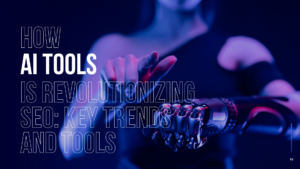For years, Search Engine Optimization (SEO) has been the holy grail of digital marketing. If you wanted your content to rank on Google, you had to play by the SEO rulebook—keywords, backlinks, metadata, and technical tweaks. But fast forward to today, and things are changing at an unprecedented pace.
Enter Generative Engine Optimization (GEO)—a game-changer in how AI-driven content ranks on search engines. With Google’s Search Generative Experience (SGE) and AI-powered search assistants like Bing Copilot reshaping search results, the old SEO tricks are no longer enough.
So, is SEO dead? Not entirely. But it’s evolving, and Generative Engine Optimization (GEO) is the future. If you’re still relying solely on traditional SEO strategies, you might be missing out on a massive opportunity. In this guide, we’ll break down what Generative Engine Optimization is, how it differs from SEO, and how you can optimize AI-generated content to stay ahead in the rankings.
Also Read: Why Answer Engine Optimization Is the Next Big Thing in Search
What Is Generative Engine Optimization (GEO)?
If you’ve been keeping up with the latest trends in AI and digital marketing, you’ve probably heard of Generative AI—the technology behind tools like ChatGPT, Google Gemini, Jasper, and Koala Writer. These AI-powered models can generate high-quality content, automate responses, and even create SEO-optimized articles. But here’s the catch: search engines are evolving, too.
That’s where Generative Engine Optimization (GEO) comes in.
GEO is the process of optimizing AI-generated content to perform well in AI-powered search engines like Google’s Search Generative Experience (SGE) and Bing Copilot. Unlike traditional SEO, which focuses on keyword rankings and backlinks, GEO prioritizes context, relevance, and AI-friendly content structuring to ensure AI-generated search results favor your content.

How Does GEO Work?
Instead of just stuffing your content with keywords, Generative Engine Optimization (GEO) focuses on:
- AI Comprehension – Structuring content so AI can easily interpret and summarize it.
- Semantic Search Optimization – Using related topics and phrases instead of exact-match keywords.
- Entity-Based Ranking – Optimizing for concepts and relationships rather than just keyword density.
- User Intent & Engagement – Ensuring content is valuable, engaging, and formatted for AI-driven search engines.
Think of Generative Engine Optimization as the next step in digital marketing. As AI-generated content becomes the norm, understanding how AI ranks and retrieves information will be the key to success.
Why Traditional SEO Strategies Are No Longer Enough
For years, SEO best practices revolved around tactics like keyword optimization, backlinks, and metadata. While these techniques are still important, they’re no longer enough in the age of AI-driven search engines. Here’s why:
1. Google’s Search Generative Experience (SGE) Is Changing Search
Google’s Search Generative Experience (SGE) is a new AI-powered search model that delivers AI-generated summaries at the top of search results. Instead of showing a list of blue links, Google now provides direct answers, pulling information from multiple sources.
What this means for you: If your content isn’t optimized for AI-generated search results, it could get buried beneath AI-generated snippets.
2. Keywords Alone Won’t Cut It Anymore
Traditional SEO relies on exact-match keywords, but AI search engines prioritize context. Google and Bing now understand semantic relationships between words, making Generative Engine Optimization (GEO) crucial for ranking.
Pro Tip: Instead of focusing solely on keywords like “best AI writing tool,” structure content around broader semantic topics like “how AI is transforming content creation.”
3. Backlinks Are Losing Their Impact
Backlinks have long been a major SEO ranking factor, but AI-driven search results are reducing their influence. With AI summarizing content instantly, search engines are relying more on content quality and engagement metrics rather than just backlinks.
What matters now? User engagement, dwell time, and AI comprehension—all core elements of Generative Engine Optimization (GEO).
4. AI Personalization Is Changing Ranking Factors
Search engines are customizing search results based on individual user behavior. This means rankings are no longer one-size-fits-all—your content must be optimized for AI’s dynamic personalization models.
How to adapt? Focus on high-quality, intent-driven content that AI deems valuable for personalized results.
The Bottom Line:
Traditional SEO isn’t dead, but it’s evolving. To stay competitive, you need to optimize content not just for human readers, but for AI-driven search engines. That’s where GEO comes in.

The Key Principles of GEO: How It Works
Now that you know why traditional SEO is no longer enough, let’s dive into how Generative Engine Optimization (GEO) actually works. Generative Engine Optimization (GEO) isn’t just about tweaking keywords—it’s about optimizing content for AI-driven search engines like Google’s Search Generative Experience (SGE) and Bing Copilot.
Here are the core principles of GEO and how you can use them to rank higher in AI-powered search results:
1. AI-Friendly Content Structuring
Why It Matters: AI search engines read and summarize content differently than humans. If your content is poorly structured, AI may not extract key insights, which means it won’t be featured in AI-generated search results.
How to Optimize:
- Use clear headings (H1, H2, H3, etc.) to break up content logically.
- Write concise, skimmable paragraphs (2–3 sentences max).
- Add bullet points, lists, and tables to make information easy for AI to digest.
Pro Tip: Think like an AI—format your content so it’s easy to scan, summarize, and extract insights from quickly.
2. Semantic Search & Natural Language Processing (NLP)
Why It Matters: Google’s AI understands context, not just keywords. Instead of ranking content based on exact-match keywords, search engines now analyze topics, intent, and semantic relevance.
How to Optimize:
- Use related phrases and synonyms instead of stuffing exact keywords.
- Optimize for search intent—why is the user searching for this?
- Answer questions directly using FAQ-style formatting.
Example: Instead of repeating “best AI tools for writing,” use variations like “top AI content generators” or “AI-powered writing assistants.”
3. Entity-Based Optimization (EBO)
Why It Matters: AI search engines now focus on entities (people, places, concepts, and relationships) rather than just words.
How to Optimize:
- Identify key entities in your topic and structure content around them.
- Use Wikipedia-style linking—connect concepts naturally within your content.
- Implement structured data (schema markup) to help AI understand your content better.
Example: If writing about AI content generation, mention related entities like “GPT-4, ChatGPT, OpenAI, Google Gemini” to establish relevance.
4. User Engagement & Behavioral Signals
Why It Matters: AI-driven search engines prioritize content that keeps users engaged. Factors like dwell time, click-through rate (CTR), and interaction signals now impact rankings more than ever.
How to Optimize:
- Write engaging, conversational content (like this!).
- Add interactive elements like videos, polls, and quizzes.
- Encourage users to stay longer by linking to related topics and deep-dive sections.
Pro Tip: Boring content doesn’t rank. Make your content valuable, interactive, and engaging to boost dwell time and ranking potential.
5. Content Personalization & Adaptability
Why It Matters: AI search engines personalize results based on user behavior, location, and past searches. If your content isn’t adaptable, it may not show up for different users.
How to Optimize:
- Use dynamic content strategies that adapt to different audiences.
- Target multiple user intents—informational, transactional, and navigational.
- Optimize for voice search by using natural, conversational phrases.
Example: A blog on “AI marketing tools” should have sections for beginners (what is AI marketing?) and advanced users (best AI tools for automation).
Key Takeaway:
Generative Engine Optimization (GEO) is all about making AI-generated content rank higher by structuring it in a way that AI understands, processes, and prioritizes.

GEO vs SEO – Key Differences and Why GEO Matters More
By now, you understand that Generative Engine Optimization (GEO) is reshaping how content ranks in AI-powered search engines. But how does it compare to traditional Search Engine Optimization (SEO)? And why should you start focusing on GEO more than SEO?
1. Focus: Keywords vs. Context & Entities
SEO: Relies on exact-match keywords and keyword density to rank content.
GEO: Prioritizes semantic search, related topics, and entity-based ranking.
Example: Instead of repeating “best AI content tools,” Generative Engine Optimization (GEO) considers variations like “top AI writing assistants” and related terms like “GPT-4, OpenAI, content automation.”
Takeaway: AI search engines now analyze the meaning behind words, so optimizing for context is more effective than stuffing keywords.
2, Ranking Signals: Backlinks vs. AI Comprehension & User Engagement
SEO: High-ranking content depends heavily on backlinks (external sites linking to your page).
GEO: AI prioritizes content clarity, user engagement (dwell time, CTR), and AI comprehension.
Example: A well-structured article with clear headings, bullet points, and summaries may outrank a backlink-heavy post if AI deems it more digestible and relevant.
Takeaway: Backlinks still help, but AI-generated search results rely more on how well content is structured for AI interpretation.
3. Search Intent: Static vs. Personalized Results
SEO: Aims to rank for one-size-fits-all search results based on static algorithms.
GEO: Ranks content dynamically, based on personalized AI-driven recommendations tailored to users.
Example: Two users searching for “best AI marketing tools” might get different results based on past behavior, device, and location.
Takeaway: To rank, your content must be adaptable to different user intents and AI-driven personalization.
4. Search Experience: Blue Links vs. AI Summaries
SEO: Traditional search results show a list of ranked links that users must click.
GEO: AI-generated search results pull key insights from content directly (Google SGE, Bing Copilot).
Example: Instead of clicking a blog, users might see an AI-generated snippet summarizing key takeaways.
Takeaway: Your content needs to be optimized for AI-generated snippets so it gets featured directly in search results.
5. Optimization Strategy: Static vs. Conversational & Interactive Content
SEO: Focuses on static, keyword-rich content that remains unchanged.
GEO: Requires interactive, conversational, and AI-friendly content with voice search compatibility.
Example: AI prefers conversational tones, FAQs, and structured lists over robotic, keyword-stuffed content.
Takeaway: AI-driven searches favor engaging, easy-to-read content—so write naturally, use FAQs, and break down complex topics.
Final Verdict: Is GEO More Important Than SEO?
Yes! Traditional SEO is still useful, but Generative Engine Optimization (GEO) is the future. AI-driven search engines prioritize context, user intent, and AI-friendly content over old-school keyword strategies.
To stay ahead, you need to optimize content for AI comprehension, engagement, and dynamic search experiences—not just search engines.
How to Implement GEO in Your Content Strategy (Step-by-Step Guide)
Now that you understand the power of Generative Engine Optimization (GEO), let’s go step by step on how to implement it effectively. If you want your content to rank in AI-driven search results and Google’s Search Generative Experience (SGE), you need to optimize it the right way.
Follow this step-by-step GEO content strategy to future-proof your rankings:
Step 1: Create AI-Friendly Content Structure
Why? AI scans and summarizes content differently than humans. A well-structured article increases your chances of getting featured in AI-generated snippets.
How to do it:
- Use clear and logical headings (H1, H2, H3, etc.)
- Write concise paragraphs (2–3 sentences each)
- Use bullet points and numbered lists for easy AI extraction
- Include bold and italic highlights for key terms
Pro Tip: Think like an AI—format your content so it’s easy to skim, summarize, and retrieve key insights.
Step 2: Optimize for Semantic Search & NLP
Why? AI-driven search engines don’t just look for exact-match keywords—they understand semantic relationships between topics.
How to do it:
- Use synonyms, related terms, and variations instead of repeating exact keywords
- Answer natural language queries (e.g., “How does AI ranking work?” instead of “AI ranking guide”)
- Add an FAQ section to capture long-tail voice search queries
Example: Instead of using only “best AI writing tools,” also include terms like “AI-powered content generators,” “AI copywriting assistants,” and “GPT-4 writing software.”
Step 3: Focus on Entity-Based Optimization (EBO)
Why? AI ranks content based on entities (people, brands, places, and concepts) rather than just keywords.
How to do it:
- Identify key entities in your niche (e.g., “OpenAI, Google Gemini, ChatGPT, SGE”)
- Mention related topics naturally within your content
- Use internal linking to connect different entities on your website
- Add structured data (schema markup) for AI-friendly content classification
Pro Tip: Think of your content like a Wikipedia page—AI prefers well-connected topics with rich contextual information.
Step 4: Maximize User Engagement & Interaction
Why? AI prioritizes content that keeps users engaged longer (dwell time, CTR, interactions).
How to do it:
- Write in a conversational tone (like this!)
- Add videos, images, polls, and interactive elements
- Break content into easy-to-digest sections
- Encourage comments, shares, and discussions
Example: Google SGE prefers highly engaging, user-friendly content—so make your blog posts dynamic and readable.
Step 5: Adapt for AI Personalization & Search Intent
Why? AI customizes search results based on user behavior and preferences, so your content must cater to multiple search intents.
How to do it:
- Identify different user intents (informational, transactional, navigational)
- Provide short, direct answers for AI summaries
- Optimize for voice search and mobile-first indexing
- Personalize content for different audience segments
Example: If a user searches “Best AI tools”, some may want detailed reviews, while others may prefer a quick comparison chart—your content should offer both.
Step 6: Optimize for AI Summaries & Featured Snippets
Why? Google SGE and AI search engines pull key snippets from content to display in AI-generated search results.
How to do it:
- Start articles with a clear, concise summary (first 100 words)
- Use FAQ schema markup to get featured in AI responses
- Format answers using structured data and lists
- Create high-authority, well-researched content
Pro Tip: AI prioritizes content clarity and credibility—so ensure your key takeaways are easy to extract.
Step 7: Track & Optimize Generative Engine Optimization (GEO) Performance
Why? AI search algorithms evolve constantly—you need to track results and optimize regularly.
How to do it:
- Monitor Google Search Console & Bing Webmaster Tools
- Track rankings in AI-generated search results
- Analyze user engagement (bounce rate, dwell time, CTR)
- Continuously update and refine content for AI relevance
Example: If Google SGE starts favoring short-form AI-generated responses, consider adding TL;DR summaries in your articles.

Final Thoughts: Future-Proofing Your Content with GEO
Generative Engine Optimization (GEO) is the future of ranking in AI-driven search engines. If you want to stay ahead, you need to optimize for AI comprehension, engagement, and personalization—not just traditional SEO tactics.
By following these Generative Engine Optimization (GEO) strategies, you’ll ensure your content ranks high in Google’s AI-driven search results (SGE), Bing Copilot, and future AI search models.
Also Read: The Future of SEO: How AI in Content Structuring Boosts Rankings
Conclusion: The Future of SEO is GEO—Are You Ready?
The digital landscape is evolving at an unprecedented pace, and Generative Engine Optimization (GEO) is at the heart of this transformation. Traditional SEO strategies that once dominated search rankings are no longer enough in an era where AI-driven search engines, Google’s Search Generative Experience (SGE), and Bing Copilot are rewriting the rules.
If you want your content to remain visible, competitive, and valuable, it’s time to shift your focus from old-school SEO tactics to AI-first Generative Engine Optimization (GEO) strategies.
Key Takeaways & Next Steps
- SEO is evolving: AI search engines prioritize context, user intent, and AI comprehension over exact-match keywords.
- AI-friendly content wins: Focus on structured data, conversational tones, and entity-based optimization.
- User engagement matters more than backlinks: AI ranks content based on readability, engagement, and personalization.
- Optimize for AI summaries & snippets: Search engines now generate their own answers—your content must be ready to be featured.


